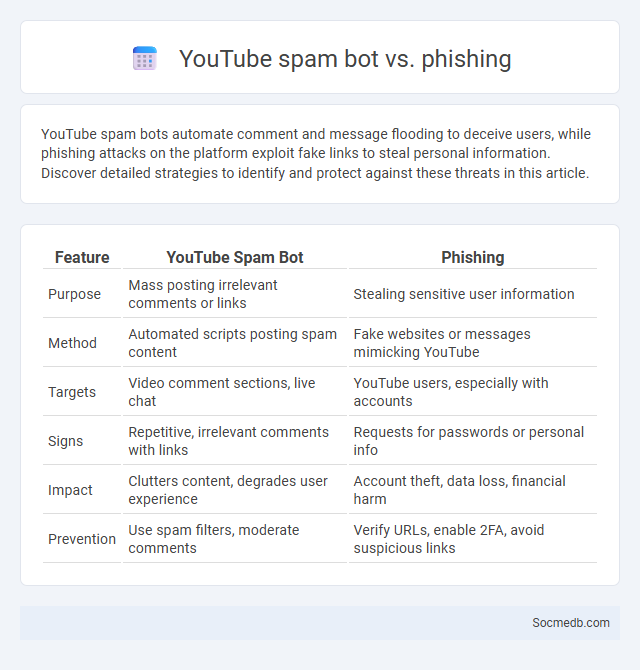
Photo illustration: YouTube spam bot vs phishing
YouTube spam bots automate comment and message flooding to deceive users, while phishing attacks on the platform exploit fake links to steal personal information. Discover detailed strategies to identify and protect against these threats in this article.
Table of Comparison
| Feature | YouTube Spam Bot | Phishing |
|---|---|---|
| Purpose | Mass posting irrelevant comments or links | Stealing sensitive user information |
| Method | Automated scripts posting spam content | Fake websites or messages mimicking YouTube |
| Targets | Video comment sections, live chat | YouTube users, especially with accounts |
| Signs | Repetitive, irrelevant comments with links | Requests for passwords or personal info |
| Impact | Clutters content, degrades user experience | Account theft, data loss, financial harm |
| Prevention | Use spam filters, moderate comments | Verify URLs, enable 2FA, avoid suspicious links |
Understanding YouTube Spam Bots: Definition and Purpose
YouTube spam bots are automated programs designed to post repetitive comments, likes, or subscriptions to manipulate engagement metrics and promote content misleadingly. These bots undermine authentic user interactions, distort channel analytics, and can lead to the spread of fraudulent links or misleading information. Detecting and preventing YouTube spam bots is essential for maintaining platform integrity and ensuring genuine community engagement.
What Is Phishing? Key Techniques and Tactics
Phishing on social media involves cybercriminals using deceptive messages or fake profiles to trick users into revealing personal information, such as passwords or financial data. Key techniques include spear phishing, where attackers target specific individuals with personalized content, and baiting, which lures victims with enticing offers or links. Social media phishing tactics often exploit trust networks and platform features like direct messaging and comments to increase the likelihood of successful scams.
How Spam Bots Operate Across Different Platforms
Spam bots exploit vulnerabilities in various social media platforms by automating mass account creation, fake interactions, and unsolicited messaging to spread advertisements or malicious links. These bots use advanced algorithms to mimic human behavior, enabling them to bypass security measures and infiltrate networks on platforms like Facebook, Instagram, Twitter, and LinkedIn. Their activities disrupt user experience, inflate engagement metrics, and pose significant risks to data privacy and cybersecurity.
Comparative Analysis: YouTube Spam Bots vs. Traditional Spam Bots
YouTube spam bots utilize advanced algorithms to mimic human behavior and exploit video comments and likes, making them more difficult to detect compared to traditional spam bots that often rely on repetitive and obvious keyword spamming across forums and emails. These bots target engagement metrics to manipulate video popularity and ad revenue, whereas traditional spam bots primarily focus on spreading unsolicited advertisements or phishing links. Understanding the differences helps you implement more effective anti-spam measures tailored to the unique challenges posed by YouTube's platform.
Phishing vs. Spam Bots: Major Differences Explained
Phishing on social media targets users with deceptive messages to steal personal information like passwords and credit card numbers, often through fake profiles or malicious links. Spam bots, in contrast, automatically generate large volumes of unsolicited content, such as advertisements or fake comments, aimed at disrupting user experience and spreading misinformation. Understanding these differences helps users recognize threats and apply appropriate security measures to protect their accounts and personal data.
Common Signs of YouTube Spam Bot Activity
Unusual spikes in video views, repetitive comments, and generic usernames often indicate YouTube spam bot activity. Bots typically post irrelevant or promotional links in comment sections, disrupting genuine user interactions. Monitoring for rapid subscription growth from suspicious accounts also helps identify automated behavior on the platform.
Consequences of Phishing Attacks on YouTube Users
Phishing attacks on YouTube users can lead to compromised personal information, unauthorized account access, and financial loss. These attacks often result in the spread of malware, disruption of content creation, and damage to a user's online reputation. Protecting your YouTube account with strong security measures is essential to avoid these harmful consequences.
Prevention Strategies: Blocking Spam Bots and Phishing Scams
Effective prevention strategies against social media threats include implementing robust spam bot detection algorithms and deploying AI-driven phishing scam filters. Utilizing machine learning models to analyze user behavior patterns significantly reduces the impact of automated accounts and malicious links. Continuous updates to security protocols and user education campaigns further enhance the platform's resilience to such cyber threats.
The Role of AI in Detecting and Mitigating Online Threats
AI enhances social media safety by accurately detecting harmful content such as cyberbullying, hate speech, and misinformation through advanced algorithms and natural language processing. Your online experience becomes more secure as AI continuously adapts to emerging threats by analyzing patterns and user behavior in real time. This proactive approach helps social platforms promptly mitigate risks and protect communities from evolving digital dangers.
Best Practices for Staying Safe from Spam Bots and Phishing
Protect Your social media accounts by enabling two-factor authentication and using strong, unique passwords to prevent unauthorized access. Regularly review privacy settings and avoid clicking suspicious links or messages from unknown sources to reduce the risk of phishing attacks. Stay vigilant by reporting spam bots, blocking fake profiles, and keeping your software and apps updated to enhance your online safety.
 socmedb.com
socmedb.com